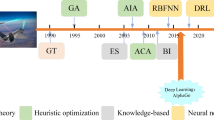Abstract
Controlled flight into terrain accidents pose a significant threat to aviation safety, emphasizing the need for effective automatic ground collision avoidance system (Auto GCAS). However, the diversity and complexity of missions present considerable challenges to aircraft collision avoidance control. This paper proposes an approach for trajectory prediction based on the model predictive control (MPC) technique. Different from previous methods that rely on predefined fixed trajectories, the proposed approach incorporates constraints of aircraft state and actual terrain to generate an optimal trajectory. The safety and effectiveness of the method are demonstrated through integrating the trajectory prediction algorithm into the Auto GCAS system. The simulation results show that the MPC-based Auto GCAS can achieve optimal collision avoidance outcomes aligned with the aircraft's performance and mission needs.











Similar content being viewed by others
Data availability
All data used during the study appear in the submitted article.
References
Kelly D, Efthymiou M (2019) An analysis of human factors in fifty controlled flight into terrain aviation accidents from 2007 to 2017. J Safety Res 69:155–165
Suplisson A W (2015) Optimal recovery trajectories for automatic ground collision avoidance systems (Auto GCAS). Dissertation, Air University
Sorokowski P, Skoog M, Burrows S, Thomas S (2015) Small UAV automatic ground collision avoidance system design considerations and flight test results. National Aeronautics and Space Administration, Armstrong Flight Research Center
Kuchar J, Yang L, Kuchar J, Yang L (2000) A review of conflict detection and resolution modeling methods. IEEE Trans Intell Transport Syst 1(4):179–189
Burns A, Harper D, Barfield AF et al (2011) Auto GCAS for analog flight control system. In: 2011 IEEE/AIAA 30th Digital Avionics Systems Conference, 8C5–1–8C5–11.
Gahan KC (2019) Multi-path automatic ground collision avoidance system for performance limited aircraft with flight tests: Project Have Medusa. Dissertation, Air University.
Swihart DE, Barfield AF, Griffin EM et al (2011) Automatic ground collision avoidance system design, integration, & flight test. IEEE Aerosp Electron Syst Mag 26(5):4–11
Lee S, Lee D and Bang H (2015) Modified algorithm of predictive ground collision avoidance system for the low level terrain flight. In: 2015 15th International Conference on Control, Automation and Systems (ICCAS), Oct.13–16, Busan, Korea, pp 197–200.
Lee S, Bang H, Lee D (2016) Predictive ground collision avoidance system for UAV applications: PGCAS design for fixed-wing UAVs and processor in the loop simulation. In: 2016 International Conference on Unmanned Aircraft Systems (ICUAS), June 7–10, Arlington, VA USA, pp 1287–1292.
Carpenter J, Gahan K, Cobb R (2019) Automatic-ground collision avoidance system (Auto-GCAS) for performance limited aircraft. In: AIAA Aviation 2019 Forum, June 17–21, Dallas, Texas, pp 3657.
Trombetta JV (2016) Multi-trajectory automatic ground collision avoidance system with flight tests (Project Have ESCAPE). Dissertation, Air University.
Suplisson A W, Cobb R, Baker W, Jacques D (2015) An optimal control approach to aircraft automatic ground collision avoidance. In: AIAA Guidance, Navigation, and Control Conference, January 5–9 , Kissimmee, Florida, pp 1316.
Panoutsakopoulos C, Yuksek B, Inalhan G, Tsourdos A (2022) Towards safe deep reinforcement learning for autonomous airborne collision avoidance systems. In: AIAA SCITECH 2022 Forum, January 3–7, San Diego, CA & Virtual, pp 2102.
De Leege A, van Paassen M, Mulder M (2013) A machine learning approach to trajectory prediction. In: AIAA Guidance, Navigation, and Control (GNC) Conference, August 19–22, Boston, MA, pp 4782.
Gibbens PW, Medagoda ED (2011) Efficient model predictive control algorithm for aircraft. J Guid Control Dyn 34(6):1909–1915
Shimizu Y (2020) Nonlinear model predictive real-time control of aircraft in collision avoidance. In: AIAA Scitech 2020 Forum, January 6–10, Orlando, FL, pp 1829
Chaloulos G, Hokayem P, Lygeros J (2010) Distributed hierarchical MPC for conflict resolution in air traffic control. In: Proceedings of the 2010 American Control Conference, June 30-July 02, Baltimore, MD USA, pp 3945–3950.
Scholte E, Campbell ME (2008) Robust nonlinear model predictive control with partial state information. IEEE Trans Control Syst Technol 16(4):636–651
Ahn H, Park J, Bang H, Kim Y (2022) Model predictive control-based multirotor three-dimensional motion planning with point cloud obstacle. J Aerosp Inform Syst 19(3):179–193
Shekhar RC, Kearney M, Shames I (2015) Robust model predictive control of unmanned aerial vehicles using waysets. J Guid Control Dyn 38(10):1898–1907
Morelli EA (1998) Global nonlinear parametric modelling with application to F-16 aerodynamics. In: Proceedings of the 1998 American Control Conference. ACC (IEEE Cat. No. 98CH36207), pp 997–1001.
Raghunathan AU, Gopal V, Subramanian D et al (2004) Dynamic optimization strategies for three-dimensional conflict resolution of multiple aircraft. J Guid Control Dyn 27(4):586–594
Smith NE, Cobb R, Pierce SJ, Raska V (2014) Optimal collision avoidance trajectories via direct orthogonal collocation for unmanned/remotely piloted aircraft sense and avoid operations. In: AIAA Guidance, Navigation, and Control Conference, January13–17, National Harbor, Maryland, pp 966.
Funding
The authors have not disclosed any funding.
Author information
Authors and Affiliations
Corresponding author
Ethics declarations
Competing interests
The authors have not disclosed any competing interests.
Rights and permissions
Springer Nature or its licensor (e.g. a society or other partner) holds exclusive rights to this article under a publishing agreement with the author(s) or other rightsholder(s); author self-archiving of the accepted manuscript version of this article is solely governed by the terms of such publishing agreement and applicable law.
About this article
Cite this article
Yuan, S., Li, Q., Lu, B. et al. Trajectory prediction for fighter aircraft ground collision avoidance based on the model predictive control technique. AS (2024). https://doi.org/10.1007/s42401-024-00300-6
Received:
Revised:
Accepted:
Published:
DOI: https://doi.org/10.1007/s42401-024-00300-6




